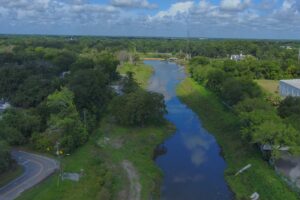See our jaw-dropping photos:
Alligators on District lands
Few creatures represent natural Florida better than the American alligator. We may take them for granted, but visitors to the Sunshine State are so enamored with gators that they’re willing to pay to view them at alligator farms.
In 1987 the Florida Legislature designated the American alligator (Alligator mississippiensis) as the official state reptile, the widely recognized symbol of Florida’s extensive untamed wilderness and swamps.
Fortunately for you, St. Johns River Water Management District public lands offer everyone the opportunity to view alligators in their natural habitat — free of charge. Just visit a District property where there’s water — a marsh, swamp, lake or even a canal — and be patient. Sometimes, they’re in plain sight, basking on the shoreline in the sunshine; other times, they’re gliding along the water’s surface with only their elongated heads slightly exposed. Is that a log sticking up in the water or is that log starting to move? You’ll figure it out once you get the hang of it.
Before you venture out, we offer these guidelines to avoid an unpleasant or even dangerous encounter:
- Leave alligators alone.Alligators are shy animals that usually avoid human contact.
- Pay attention.Keep an eye on your surroundings near fresh or brackish waters. Avoid vegetation-filled areas of rivers, lakes and other bodies of water.
- Do not feed alligators.Feeding alligators is illegal. Alligators that are fed will come to associate humans with food and will lose their natural fear.
- Throw fish scraps into trash cans.Do not discard fish scraps in the water at fish camps or boat ramps — you will unintentionally feed alligators.
- Follow directions on signs.Do not swim outside of posted swimming areas.
- Stay with children.Never allow small children to play unattended near water.
- Keep an eye on your pets.Dogs are in more danger from alligators than humans, because they resemble the reptiles’ natural prey. Do not let your dog swim in waters where you know alligators live.
We encourage safety, but we’re not trying to frighten you. You are more likely to be struck by lightning than attacked by an alligator in Florida, according the University of Florida, Institute of Food and Agricultural Sciences.
Today, we share our favorite alligator photos taken by our talented District staff on some of the more than 772,000 acres of land we own or manage within our 18-county jurisdiction. (We buy land in the course of our work to protect and preserve water resources. In addition, these lands protect plant and wildlife habitat and provide areas for public recreation and environmental education.) Keep in mind that our staff used telephoto lenses to capture these close-ups; we respect those jaws!
Looking for more in-depth information about alligators? The Florida Fish and Wildlife Conservation Commission offers everything you need to know at https://myfwc.com/wildlifehabitats/profiles/reptiles/alligator.





